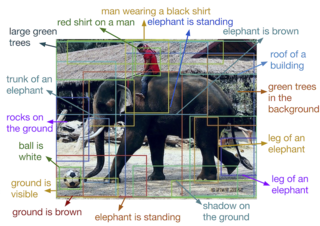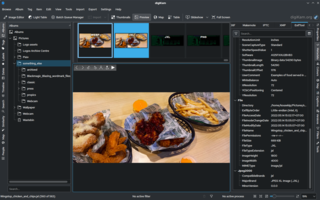Information retrieval (IR) in computing and information science is the task of identifying and retrieving information system resources that are relevant to an information need. The information need can be specified in the form of a search query. In the case of document retrieval, queries can be based on full-text or other content-based indexing. Information retrieval is the science of searching for information in a document, searching for documents themselves, and also searching for the metadata that describes data, and for databases of texts, images or sounds.
Music information retrieval (MIR) is the interdisciplinary science of retrieving information from music. Those involved in MIR may have a background in academic musicology, psychoacoustics, psychology, signal processing, informatics, machine learning, optical music recognition, computational intelligence or some combination of these.
An image retrieval system is a computer system used for browsing, searching and retrieving images from a large database of digital images. Most traditional and common methods of image retrieval utilize some method of adding metadata such as captioning, keywords, title or descriptions to the images so that retrieval can be performed over the annotation words. Manual image annotation is time-consuming, laborious and expensive; to address this, there has been a large amount of research done on automatic image annotation. Additionally, the increase in social web applications and the semantic web have inspired the development of several web-based image annotation tools.

Content-based image retrieval, also known as query by image content and content-based visual information retrieval (CBVIR), is the application of computer vision techniques to the image retrieval problem, that is, the problem of searching for digital images in large databases. Content-based image retrieval is opposed to traditional concept-based approaches.

In information systems, a tag is a keyword or term assigned to a piece of information. This kind of metadata helps describe an item and allows it to be found again by browsing or searching. Tags are generally chosen informally and personally by the item's creator or by its viewer, depending on the system, although they may also be chosen from a controlled vocabulary.

Automatic image annotation is the process by which a computer system automatically assigns metadata in the form of captioning or keywords to a digital image. This application of computer vision techniques is used in image retrieval systems to organize and locate images of interest from a database.

JabRef is an open-source, cross-platform citation and reference management software. It is used to collect, organize and search bibliographic information.

An image organizer or image management application is application software for organising digital images. It is a kind of desktop organizer software application.
Faceted search augments lexical search with a faceted navigation system, allowing users to narrow results by applying filters based on a faceted classification of the items. It is a parametric search technique. A faceted classification system classifies each information element along multiple explicit dimensions, facets, enabling the classifications to be accessed and ordered in multiple ways rather than in a single, predetermined, taxonomic order.
A concept search is an automated information retrieval method that is used to search electronically stored unstructured text for information that is conceptually similar to the information provided in a search query. In other words, the ideas expressed in the information retrieved in response to a concept search query are relevant to the ideas contained in the text of the query.

A digital library is an online database of digital objects that can include text, still images, audio, video, digital documents, or other digital media formats or a library accessible through the internet. Objects can consist of digitized content like print or photographs, as well as originally produced digital content like word processor files or social media posts. In addition to storing content, digital libraries provide means for organizing, searching, and retrieving the content contained in the collection. Digital libraries can vary immensely in size and scope, and can be maintained by individuals or organizations. The digital content may be stored locally, or accessed remotely via computer networks. These information retrieval systems are able to exchange information with each other through interoperability and sustainability.
Projekt Dyabola is a software for creating and browsing bibliographic data and image collections, specifically targeted to the humanities community. The program is built and maintained by the Biering & Brinkmann company of Germany, and access to a web version is available through subscription. The service is available in six languages.

World Heritage Memory Net (WHMNet), a partnership project with UNESCO World Heritage Centre, is a global digital library of cultural, historical, and heritage multimedia collections related to the current 962 UNESCO World Heritage Sites of 157 State Parties. Of these 962 sites, 745 are cultural sites, 188 natural, and 29 mixed and 38 of the total 962 are in danger. WHMNet was officially launched April 29, 2011, and can be thought of as “the world’s heritage at your fingertips.”

Reverse image search is a content-based image retrieval (CBIR) query technique that involves providing the CBIR system with a sample image that it will then base its search upon; in terms of information retrieval, the sample image is very useful. In particular, reverse image search is characterized by a lack of search terms. This effectively removes the need for a user to guess at keywords or terms that may or may not return a correct result. Reverse image search also allows users to discover content that is related to a specific sample image or the popularity of an image, and to discover manipulated versions and derivative works.
Concept-based image indexing, also variably named as "description-based" or "text-based" image indexing/retrieval, refers to retrieval from text-based indexing of images that may employ keywords, subject headings, captions, or natural language text. It is opposed to Content-based image retrieval. Indexing is a technique used in CBIR.

Ching-chih Chen is an educator, administrator, consultant, and speaker in the field of digital information management and technology. After her 10-year administrative experience, and 49-year teaching, research, consulting and speaking activities, she became professor emeritus of Simmons College in June 2010, and president of Global Connection and Collaboration, Inc., a non-profit tax-exempt 501(c)(3) organization.
Howard Besser is a scholar of digital preservation, digital libraries, and preservation of film and video. He is Professor of Cinema Studies and the founding director of the NYU Moving Image Archiving and Preservation Program ("MIAP"), a graduate program in the Tisch School. Besser also worked as a Senior Scientist at New York University's Digital Library Initiative. He conducted extensive research in image databases, multimedia operation, digital library, and social and cultural influence of the latest Information Technology. Besser is a prolific writer and speaker, and has consulted with many governments, educational institutions, and arts agencies on digital preservation matters. Besser researched libraries' new technology, archives, and museums. Besser has been actively contributing at the international level to build metadata and upgrade the quality of the cultural heritage community. He predominantly, focused on image and multimedia databases; digital library aspects ; cultural and societal impacts of information technology, and developing new teaching methods through technology such as web-based instructions and distance learning. Besser was closely involved in development of the Dublin Core and the Metadata Encoding and Transmission Standard (METS), international standards within librarianship.
Image collection exploration is a mechanism to explore large digital image repositories. The huge amount of digital images produced every day through different devices such as mobile phones bring forth challenges for the storage, indexing and access to these repositories. Content-based image retrieval (CBIR) has been the traditional paradigm to index and retrieve images. However, this paradigm suffers of the well known semantic gap problem. Image collection exploration consists of a set of computational methods to represent, summarize, visualize and navigate image repositories in an efficient, effective and intuitive way.
A 3D Content Retrieval system is a computer system for browsing, searching and retrieving three dimensional digital contents from a large database of digital images. The most original way of doing 3D content retrieval uses methods to add description text to 3D content files such as the content file name, link text, and the web page title so that related 3D content can be found through text retrieval. Because of the inefficiency of manually annotating 3D files, researchers have investigated ways to automate the annotation process and provide a unified standard to create text descriptions for 3D contents. Moreover, the increase in 3D content has demanded and inspired more advanced ways to retrieve 3D information. Thus, shape matching methods for 3D content retrieval have become popular. Shape matching retrieval is based on techniques that compare and contrast similarities between 3D models.
Shih-Fu Chang is a Taiwanese American computer scientist and electrical engineer noted for his research on multimedia information retrieval, computer vision, machine learning, and signal processing.








